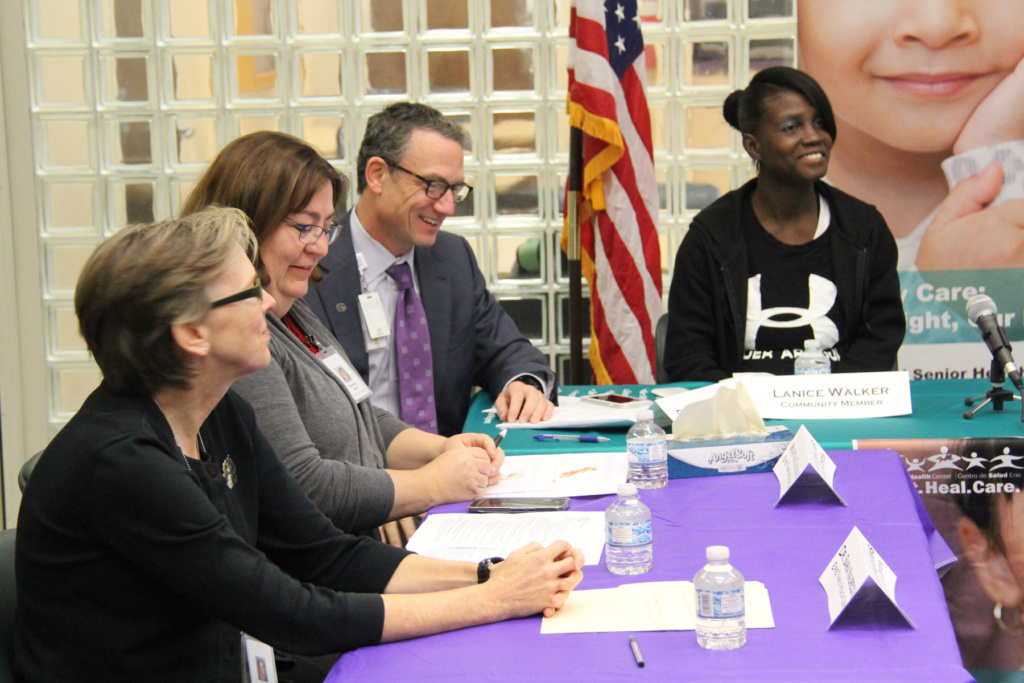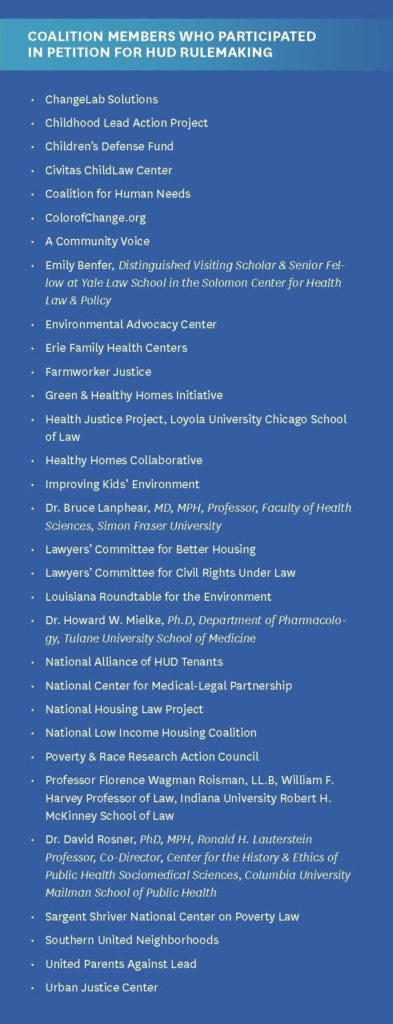The first sign that a home has a lead hazard is usually when a child tests positive for lead poisoning. Despite the fact that more than four million children in the United States live in federally assisted housing and many of those units are decades old, homes are not assessed for lead hazards before families move in. Because of Chicago’s old housing stock, providers at Erie Family Health Centers vigilantly check children’s lead levels every six months until the child is four, and whenever there is a new risk factor introduced into a child’s environment. That’s where, in 2012, just months after moving into a new home with her federal Housing Choice Voucher (HCV), Lanice Walker’s four year-old daughter screened positive for lead poisoning.
 Nurse practitioner Martha Glynn immediately called the Chicago Department of Public Health to report the elevated lead level, and to request an inspection. The city inspectors found leadbased paint hazards in the home, but the landlord — who was under a year-long contract with the Chicago Housing Authority (CHA) — refused to do anything about the hazards.
Nurse practitioner Martha Glynn immediately called the Chicago Department of Public Health to report the elevated lead level, and to request an inspection. The city inspectors found leadbased paint hazards in the home, but the landlord — who was under a year-long contract with the Chicago Housing Authority (CHA) — refused to do anything about the hazards.
Ms. Walker repeatedly called CHA, asking them to intervene and force improvements to the unit. However, the problem was not an emergency by CHA standards. Even though her daughter’s elevated blood lead level caused neurological problems, it didn’t meet the level that would require the housing authority to take action. At the time, the Department of Housing and Urban Development’s (HUD) definition of lead poisoning was four times the Centers for Disease Control and Prevention (CDC) reference
value standard.
Moving wasn’t an option for the Walkers either, or for other families in the HCV Program. Under federal law, families who live in federally assisted housing are not allowed to move out of a home with a lead hazard before the end of the lease term — even after their child has been poisoned and experiences health problems — and still maintain their housing assistance. So Ms. Walker faced an impossible choice: stay where her daughter was being poisoned, or become homeless.

Sara Naureckas, MD, Director of Child and Adolescent Medicine, Martha Glynn, FNP, Site Medical Director, School-Based Health Centers, and Lee Francis, MD, MPH, President & CEO, all of Erie Family Health Centers, listen to Erie patient, mom, and advocate Lanice Walker, discuss the impact of lead contamination on her family during a meeting with U.S. Senator Richard Durbin (D-IL). Photo credit: Scott Wills, Erie Family Health Centers.
During the time Ms. Walker was trying to get CHA to take action, all eight of her other children also tested positive for lead. It was then that Ms. Glynn referred Ms. Walker to the health center’s medical-legal partnership with Loyola University Chicago School of Law and LAF Chicago. Attorneys contacted CHA and successfully obtained a reasonable accommodation under the Americans with Disabilities Act. This allowed the Walkers to move immediately, while retaining their housing assistance. The attorneys ensured that the family’s new home was inspected for lead and hazards were abated before the family arrived. The children’s lead levels went down, but ultimately, years of lead poisoning had resulted in permanent neurological damage.
“This is why prevention of lead poisoning is so important,” said Dr. Sara Naureckas, Medical Director for Child and Adolescent Health at Erie Family Health Centers. “Once a child ingests or inhales lead, it can be stored in the bones and continue to harm the child for years.”
To deal with the lasting effects of lead exposure, the MLP attorneys helped Ms. Walker obtain special education services for her daughter and public benefits to increase the family’s income. In addition, they connected the family with a personal injury attorney to address the negligent harm caused to the family.
Having seen the devastating and permanent effect lead has had on so many kids, and motivated by the Walkers’ experience and those of other families at Erie, the MLP focused their efforts on prevention. They knew this problem was not unique to Chicago, so they built a nationwide coalition of affected families, community organizations, renowned scientists, and public health practitioners to petition HUD to amend the antiquated Lead Safe Housing Rule, which had not been updated since the 1990s.
They requested that HUD adopt the CDC’s definition of lead poisoning, a change which would have forced housing authority interventions and a move to a safe home two years earlier for the Walkers, without needing the assistance of lawyers. Among other improvements, the petition also asked for mandated data sharing and reporting between housing authorities, public health departments, and HUD to help identify kids with elevated lead levels as soon as possible. Without this change, it was impossible to know the number of kids lead poisoned in federally assisted housing units each year.
 After submitting the petition and engaging in a big media push that helped engage members of Congress, these proposed changes were successfully implemented in January 2017. Another critical change to the rule required that if a child in a federally assisted housing unit tests positive for lead poisoning, a lead hazard risk assessment must automatically be conducted on all other assisted units in the same building.
After submitting the petition and engaging in a big media push that helped engage members of Congress, these proposed changes were successfully implemented in January 2017. Another critical change to the rule required that if a child in a federally assisted housing unit tests positive for lead poisoning, a lead hazard risk assessment must automatically be conducted on all other assisted units in the same building.
“This is a very exciting step in moving HUD toward a primary prevention model for lead poisoning,” says Emily Benfer, founder and former director of the Health Justice Project and Clinical Professor of Law at Loyola University Chicago School of Law. “But unless all units are inspected and made lead safe before families move in, children will continue to be poisoned and suffer lifelong health and developmental repercussions.”
After the coalition’s petition, HUD released The Lead-Safe Homes, Lead-Free Kids Toolkit that encouraged local public housing authorities to conduct pre-rental lead hazard assessments, and advised them on the funding streams they could use to pay for the inspections. However, federal regulations still do not yet require the pre-rental risk assessment, or give families a right to move and maintain public assistance when lead hazards are identified. Across the country there are only eight cities and five states that require any pre-rental lead hazard inspection before a family moves into a home. When enforced, those laws dramatically reduced lead poisoning rates among children.
Today, Ms. Walker and Erie Family Health Centers are part of a growing coalition to advocate for the 2017 Lead Safe Housing for Kids Act (S.1845), which would mandate both of these changes in public housing regulations, and protect millions of children from severe health and developmental problems. Senator Dick Durbin (D-IL) became a co-sponsor of the bill after meeting with Ms. Walker and the MLP team. Senators Tim Scott (R-SC), Bob Menendez (D-NJ), Todd Young (R-IN), Joe Donnelly (D-IN), Tammy Duckworth (D-IL), Tim McCain (D-VA), and Rob Portman (R-OH) are also co-sponsors. The Erie MLP has reached out to colleagues at medical-legal partnerships in other states to find local groups and families willing to meet with Senators and Representatives and build support for the bill. In several cities, the coalition has secured support from landlords, inspection companies, and public housing authorities. And if they can get the bill passed, they have their eye toward supporting efforts that would improve lead standards in all housing types, not just federally assisted housing.
In reflecting on the HUD changes and the momentum for the bill, Ms. Benfer attributes success to the interprofessional, big tent nature of the coalition. “This is not just a legal issue,” she said. “It isn’t solely a housing issue or a health issue. Lead poisoning prevention is about protecting this generation of children, and all that follow. When it comes to our children, each of us has a role to play. Having medical, public health, science, and legal partners, as well as affected families at the table gave us so much credibility and broadened our perspective. As we learned from each other, the definition of the problem became more accurate, so the solution became more targeted and effective. We can advance social change so much more effectively, thoughtfully, and quickly working together.”
Story by Kate Marple and Erin Dexter
Click here to download the story PDF.
